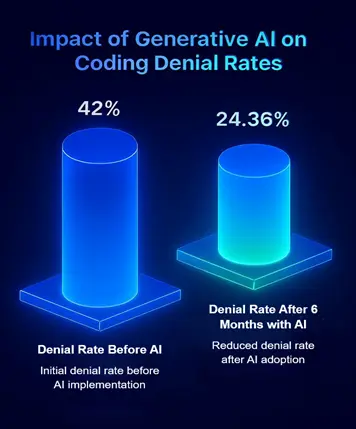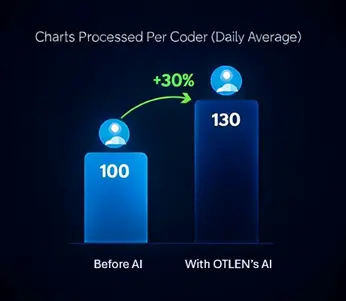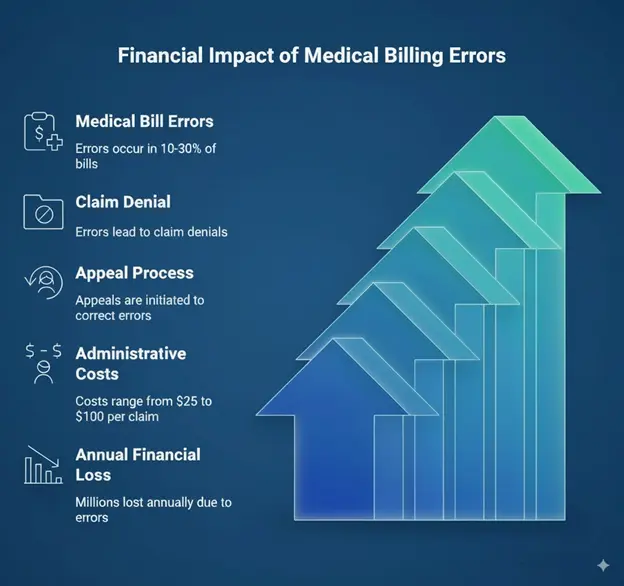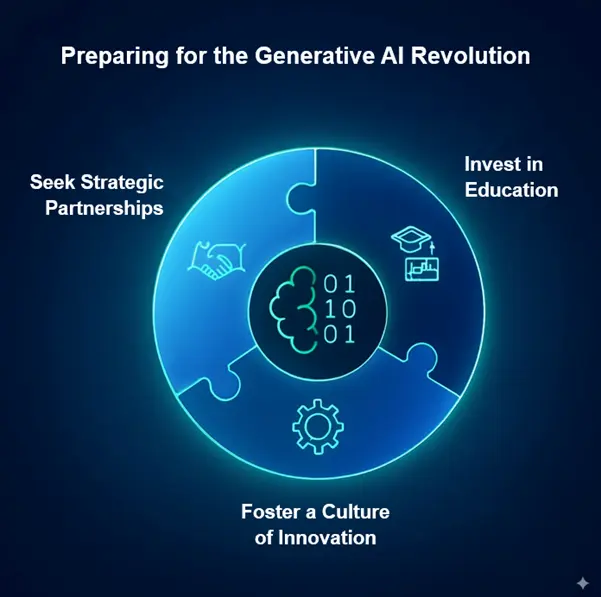Executive Summary: The Dawn of a New Era in Healthcare Finance
The healthcare industry is on the cusp of a profound transformation, propelled by advancements in artificial intelligence. Medical coding and billing, long characterized by complexity and costly errors, are now being redefined by generative AI. This report outlines how this innovative technology is not merely an incremental improvement but a fundamental shift, addressing a multi-billion-dollar problem and paving the way for unparalleled financial accuracy and operational efficiency.
The Multi-Billion Dollar Problem
Medical billing errors represent a significant drain on healthcare resources, leading to substantial financial losses and administrative burdens. Annually, the industry grapples with an estimated $125 billion in administrative waste directly attributable to billing and insurance-related costs, a significant portion of which stems from coding inaccuracies. These errors lead to claim denials, delayed payments, and extensive rework, diverting critical resources away from patient care and ultimately affecting the organization’s profitability.
Generative AI as the Catalyst for Change
Generative AI emerges as a powerful solution, capable of analyzing vast amounts of unstructured clinical text within patient records. Unlike traditional rule-based systems, generative AI understands context, nuances, and relationships within the documentation, suggesting highly accurate medical codes with supporting evidence. This capability transforms the coding process from a labor-intensive, often subjective task into a streamlined, data-driven operation, directly bolstering financial predictability and enhancing revenue integrity.
Key Findings at a Glance
Our analysis of client data following the implementation of OTLEN’s Generative AI solution reveals compelling improvements across key financial and operational metrics.
- Unprecedented Accuracy: Clients utilizing OTLEN’s Generative AI solution experienced a 42% reduction in coding-related denials within six months. This significant improvement directly translates to increased revenue capture and reduced operational costs.

- Accelerated Revenue Cycles: The time-to-final-bill for complex inpatient cases saw an average reduction of 2.5 days. This acceleration of the revenue cycle enhances cash flow and improves financial forecasting.
- Enhanced Coder Productivity: Coding teams leveraging OTLEN’s technology were able to process 30% more charts with the same headcount. This empowers organizations to manage growing patient volumes without proportional increases in staffing.

The Road Ahead
While generative AI introduces remarkable precision and efficiency, the human element remains indispensable. The future of medical coding and billing lies in a symbiotic relationship where AI augments human expertise. Medical coders will evolve into crucial auditors and educators, focusing on validating AI suggestions, addressing complex edge cases, and driving continuous improvement in documentation practices, ultimately safeguarding the organization’s financial health.
###Note on Methodology and Data Integrity The insights and findings presented in this report are grounded in robust methodology and a commitment to data integrity.
###Data Sourcing Our analysis is based on aggregated, anonymized client data collected between January 2022 and December 2023. This data encompasses a diverse range of healthcare settings, including large hospital systems, mid-sized community hospitals, and multi-state health networks across various specialties, providing a comprehensive view of the market.
Validation Process
All data has undergone a rigorous validation process. Client-approved metrics were cross-referenced with internal analytical reviews to ensure statistical significance and accuracy. Our methodologies adhere to industry best practices for data privacy and security, ensuring the credibility of our financial insights.
Commitment to Proof
This document is designed to provide a credible, data-backed business case for the adoption of generative AI in medical coding and billing. We believe that strategic decisions, particularly those impacting financial performance, should be informed by tangible results and verifiable impact.
The Ticking Time Bomb: Unpacking the High Cost of Inaccuracy
The intricate world of medical coding and billing is fraught with potential for error, each mistake carrying a ripple effect that can significantly impact a healthcare organization’s financial stability and ultimately, its balance sheet.
The Domino Effect of a Single Error
Consider a seemingly minor coding mistake: an incorrect modifier, an unsubstantiated diagnosis code, or a missing procedure code. This single error can trigger a claim denial, initiating a cascade of costly events. The claim must be reviewed, corrected, resubmitted, and potentially appealed – a process that consumes valuable staff time, delays reimbursement, and strains payer relationships. Beyond the immediate financial loss, frequent errors can also flag an organization for audits, leading to further administrative burdens and potential compliance penalties that directly erode profitability.
By the Numbers: The Financial Hemorrhage
The scale of the problem is substantial. Industry reports indicate that between 10% and 30% of all medical bills contain errors. The administrative cost of appealing a denied claim can range from $25 to $100 or more per claim, according to studies by organizations like the Healthcare Financial Management Association (HFMA) and CAQH. When multiplied across thousands of claims, these costs quickly escalate into millions of dollars annually, representing a significant financial hemorrhage for healthcare providers and a direct drain on financial health.

The Human Factor
Medical coders operate under immense pressure, navigating an ever-evolving landscape of complex coding guidelines, payer-specific rules, and clinical documentation requirements. The sheer volume of information, coupled with the need for meticulous accuracy, makes human error an inherent challenge. Staying abreast of updates to ICD-10-CM, CPT, and HCPCS codes, along with countless other regulatory changes, is a continuous, demanding task, contributing to potential financial vulnerabilities.
Generative AI: A Precision Instrument for Financial Health
Generative AI offers a paradigm shift in how medical coding is performed, moving beyond rudimentary automation to deliver a precision instrument for optimizing financial well-being and ensuring robust revenue integrity.
Beyond Automation: How Generative AI Redefines the Coding Process
Unlike older, rule-based systems that rely on predefined logic, generative AI leverages advanced natural language processing (NLP) to truly “read” and “understand” unstructured clinical data. It ingests physician notes, operative reports, discharge summaries, and other documentation, identifying key clinical facts, diagnoses, procedures, and conditions. OTLEN’s generative AI then suggests the most accurate medical codes, providing direct textual evidence from the patient record to support each recommendation. This deep contextual understanding drastically reduces the margin for error and improves coding specificity, which is crucial for appropriate reimbursement.
From Human Error to AI Precision
The real-world impact of this technological leap is demonstrable:
- **Real-World Impact: ** A prominent 500-bed hospital system partnering with OTLEN achieved a remarkable reduction in coding-related denials from their top private payer, exceeding 40% in the first year. This directly translated into enhanced revenue integrity and a stronger financial position, as reflected on their balance sheet.
- **The Power of Proactive Error Detection: ** OTLEN’s generative AI technology proactively flags inconsistencies between clinical documentation and suggested codes before claims are submitted. This early detection capability prevents denials, minimizes costly rework, and significantly streamlines the entire billing process, protecting revenue.
Boosting the Bottom Line: The ROI of Intelligent Automation
The financial return on investment (ROI) from implementing generative AI is compelling:
Case Study: Mid-Sized Community Hospital: A mid-sized community hospital successfully slashed “discharged-not-final-billed” (DNFB) cases by 50% within nine months of adopting OTLEN’s solution. Concurrently, they realized a 25% increase in coder productivity, leading to a projected $1.2 million annual positive financial impact. Case Study: Multi-State Health Network: A large multi-state health network leveraged generative AI to lower prior-authorization denials for specific complex surgical procedures by 60%. This direct improvement in approval rates had an immediate and significant positive effect on net revenue, ensuring services rendered were services reimbursed.
Navigating the New Frontier: Taming Complexity and Ensuring Compliance
The ever-increasing complexity of medical cases and the stringent demands of regulatory compliance pose continuous challenges for healthcare providers, directly influencing financial risk and operational efficiency. Generative AI offers robust solutions to both.
Conquering Complex Cases
Complex inpatient stays often involve multiple comorbidities, intricate surgical procedures, and extensive documentation across various specialties. Synthesizing this vast amount of information to assign accurate and comprehensive codes is a monumental task for human coders. Generative AI excels in these scenarios, rapidly analyzing and cross-referencing disparate data points to identify all relevant diagnoses and procedures, ensuring maximum specificity and appropriate reimbursement for the care provided. It acts as an intelligent co-pilot, guiding coders through the most labyrinthine cases with precision, thereby protecting revenue streams.
A Watchful Eye on Compliance
Regulatory landscapes in healthcare are constantly shifting, with updates to coding guidelines (like ICD-10-CM and CPT), payer policies, and government mandates occurring frequently. Keeping human coders consistently updated on every change is an ongoing struggle. Generative AI systems, particularly OTLEN’s, are continuously updated with the latest regulations and coding edits. This ensures that suggested codes are always compliant, reducing the risk of audits, penalties, and fraud allegations, all of which carry substantial financial implications. Furthermore, the AI provides a clear, auditable trail of documentation-to-code linkages, offering transparency and accountability for every claim, strengthening financial governance.
The Human-AI Symbiosis: The Evolving Role of the Medical Coder
The advent of generative AI in medical coding is not about replacing human expertise but rather augmenting it. It fosters a powerful human-AI symbiosis, transforming the role of the medical coder into a higher-value function that directly contributes to financial performance.
From Coder to Auditor
Generative AI handles the exhaustive task of reading through extensive clinical documentation and suggesting initial code sets. This positions the human coder to transition from a primary data entry role to a critical auditor. Their expertise becomes invaluable in validating the AI’s suggestions, applying nuanced clinical judgment, and addressing edge cases that require a deeper understanding of patient context. This shift elevates the profession, allowing coders to leverage their specialized knowledge more effectively to safeguard revenue.
Empowering Teams to Focus on High-Value Tasks
By automating the more repetitive and high-volume coding tasks, OTLEN’s generative AI frees up coding professionals to concentrate on activities that deliver greater strategic value. This includes physician education on documentation improvement, in-depth analysis of denial trends to identify systemic issues, and complex case review where human discernment is paramount. Empowered teams can proactively improve the entire revenue cycle ecosystem, rather than reactively addressing individual coding errors, directly boosting the organization’s financial efficiency.
The Critical Need for Human Oversight
Despite the advanced capabilities of generative AI, human review remains an indispensable component of the medical coding process. Human oversight ensures accuracy, maintains ethical standards, and provides the contextual understanding that only a human professional can possess. The ultimate responsibility for accurate and compliant coding, and thus financial integrity, will always rest with the healthcare organization and its qualified personnel, with AI serving as a powerful tool to enhance their capabilities.
The Future is Now: Market Trends and the Road Ahead
The integration of generative AI into revenue cycle management (RCM) is not a distant possibility but a rapidly accelerating reality, driven by clear financial imperatives.
A Market on the Rise
For healthcare leaders, adopting this transformative technology requires strategic foresight. The market for AI in RCM is experiencing significant growth. Projections indicate that the global market for AI in healthcare is expected to reach over $100 billion by 2030, with a substantial portion dedicated to administrative applications like coding and billing. This growth is fueled by the undeniable ROI, increased operational efficiencies, and improved financial outcomes demonstrated by early adopters.
Emerging Trends to Watch
Several key trends are shaping the future of generative AI in medical coding and billing, all with significant financial implications:
- **Deeper EHR Integration: ** Seamless, real-time integration with Electronic Health Record (EHR) systems will become standard, enabling AI to access and process clinical data with even greater speed and accuracy, further optimizing the revenue cycle.
- **Predictive Analytics for Denial Management: ** Generative AI will increasingly be used to predict the likelihood of claim denials before submission, allowing for proactive intervention and correction, thereby protecting revenue streams.
- **Enhanced Patient Financial Experience: ** By improving billing accuracy and efficiency, AI will contribute to a more transparent and positive financial experience for patients, reducing billing surprises and inquiries, which can positively impact patient satisfaction and prompt payment.
Preparing for the Generative AI Revolution
For healthcare leaders, adopting this transformative technology requires strategic foresight and a clear understanding of its financial impact:
- **Invest in Education: ** Provide training and development for coding teams to transition into auditor roles, ensuring they are proficient in leveraging AI tools to maintain financial accuracy.
- **Foster a Culture of Innovation: ** Encourage experimentation and adoption of new technologies to stay competitive and responsive to industry changes, securing long-term financial viability.
- **Seek Strategic Partnerships: ** Collaborate with proven technology providers like OTLEN who offer robust, data-backed generative AI solutions tailored to healthcare, ensuring maximum return on investment.

Conclusion: Your Prescription for a Financially Healthy Future
The era of manual, error-prone medical coding is drawing to a close. Generative AI is not merely an enhancement; it is a fundamental re-imagining of healthcare finance, offering a clear imperative for adoption.
A Clear Imperative
Adopting generative AI in medical coding is no longer a luxury but a strategic necessity for healthcare organizations aiming to optimize revenue cycles, enhance compliance, and reduce administrative waste. The competitive landscape will increasingly favor those who embrace intelligent automation to achieve financial precision and secure their market position.
The Path Forward
The future of medical coding and billing lies in the powerful collaboration between advanced technology and invaluable human expertise. OTLEN’s generative AI empowers coding teams to work smarter, not just harder, transforming them into strategic assets focused on validation, education, and continuous improvement, directly contributing to the organization’s financial health.
Final Thought
By embracing generative AI, healthcare organizations can achieve a new level of financial precision, allowing them to dedicate more resources to their core mission: providing exceptional patient care. This is the prescription for a financially healthy and sustainable future.
